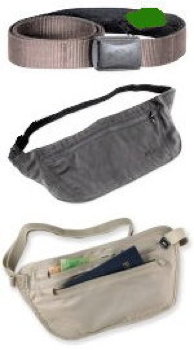
|
Folk Dance Federation of California, South, Inc.
|

|
CLICK IMAGE TO ENLARGE
 Because many folk dancers will be going on trips this summer, here is some good advice.
Because many folk dancers will be going on trips this summer, here is some good advice.
She was small, middle-aged, and obviously American. Clutching her small purse in front of her under a hip-length jacket, she stood in the crowded Prague subway train with her back pressed against the wall of the car. Fatigued from the stress of travel and being in a strange place, she was relieved when the young man towering over her turned a friendly, smiling face and spoke to her in fluent, though accented, English.
Moments later, after the young man exited the car at the next stop, she discovered that her carefully guarded purse was gone. Wallet, credit cards, traveler's checks, cash — all disppeared in a moment of deiverted attention.
This event actually happened within three feet of the woman's husband and several travel companions who were all totally unaware of her plight.
It happens all too often. One of the spin-offs of the Soviet Union's demise is the increased activity of the criminal element in many European cities. The Russian mafia is very real and European police, especially those in the former East Block, are woefully unprepared to deal with it. It's threat to travelers is primarily this kind of theft by highly skilled thieves and pickpockets, trained by the underground criminal community. Little evidence exists of physical danger but a theft is bad enough and can ruin a wonderful, long-planned vacation or important business trip.
It becomes, therefore, your responsibility to take personal precautions to recognize and avoid the danger. This article will focus on theft avoidance rather than self-defense against a physical attack. It is not difficult, but it must be given some thought.
Psychologists tell us that, while a man's field of awareness is about a twenty-five foot radius, women's awareness of people and events around them covers a radius of less than ten feet. There is nothing sexist in this finding; it is something inherited from pre-historic roles of the man as a hunter and protector and the woman as keeper of the hearth; it is something of which women should be aware, however.
Therefore, your first concern is to develop an acute awareness of your environment. Look at the people around you. Look at the street or walkway or room in which you find yourself. See how many people are there and what they are doing. Be aware of changes in the scene. Sense where their attention s focused. Feel if it is on you.
These are skills that you can develop just as you do conversational or social skills. Practice and develop them in an area with which you are familiar; work on them until they beome second nature. Because you will probably utilize public transportation and spend time in puplic areas during your trip, parctice on the public transporatation and public areas of your home: busses, street cars, shopping malls, museums, parking lots. You do not need to expose yourself to possibly dangerous situations; just develop the habits of being alert, aware, and responsive.
What to look for? Personal security experts advise several pre-incident indications, based on known typical behavior patterns of pickpockets, muggers, etc.
- Unnatural impediments to your movement.
- If there is no reason for someone to be in your way, beware. It may be casual or unintentional, or it may be a distraction to divert your path into a position to rifle your purse. Instantly be aware of others near you and take evasive action by changing your route in a direction you choose. Always be aware of an escape route.
- A movement or behavior that diverts your attention.
- Diversion is a major tool of magicians and pickpockets alike. It takes only the briefest moment of having your attention diverted for an acomplice to complete the theft. You will not feel or hear it.
- Movements that correlate to or intercept your own.
- This is the time to turn on your sixth sense. If someone is in your sphere of awareness too long or suddenly appears with no apparent destination, warning bells should begin to ring. Alter your path to put distance between you and them. Look them in the eye and let them realize that you know they are there. This is frequently your best defense.
- A total stranger attempts to initiate a verbal exchange.
- A major alarm! You might be looking for Mr. Right with a charming accent, but don't count on this being the one. These guys are expert at manipulating an apparently innocent situation, distracting their intended victim verbally or physically, and positioning them to the pickpocket's advantage.
- An abrupt, apparently accidental physical contact.
- A favorite form of diversion, because you will most likely be unable to identify either the one who bumped you or the one who took your wallet during the encounter.
Obviously there are others, but these give you a good idea. Realize that diversiion is the thief's major objective. There may be only one person, but more often there are two or three, working as a team. Having a lot of people around is no guarantee of safety; many thieves prefer a crowd into which they can disappear.
By being aware of their methods and the pre-incident indicators, you have a distinct advantage. Counter measures on your part can neutralize the vast majority of theft attempts.
Dress down; try to blend in the crowd. Americans stand out in almost any crowd and it's not just the clothes. Americans behave like . . . Americans. Americans are unique in the world. We are considered to be unbelievably wealthy and are favorite targets. If you are familiar with the country in which you travel, save your expensive wardrobe and hairdo for the proper time and dress as the locals do. Try not to carry a large tourist handbag or tote bag. If you do, don't carry your valuables in it.
Carry valuables in a hidden place. There are a number of money belts, money shoulder holsters, and other devices for secret carrying of valuables. Find one you are comfortable with and use it. Even if a thief knows you have one, he prefers to find someone whose cash is more accessible.
Another thought: if you think a threat is near, do not pat your secret cache to be sure it's there; it simply tells the thief where it is and could entice him into continued stalking or even escalation to violence, should the opportunity arise later.
Realize that a thief will opt for the easy mark. If you are inaccessible, are aware of his intentions, are percieved as a questionable risk, your possibility of being a victim is geatly reduced.
Security experts have devised a system of rating levels of awareness that might be useful.
- Condition White — Oblivious to your environment.
- You are focused on something other than the people around you and where you are. When in public, at home, or traveling, this is a dangerous place to be.
- Condition Yellow — Aware of your environment.
- You are scanning the people around you, the buildings, streets, traffic — just looking to see what's there. This is where you should be any time you are not home.
- Condition Orange — A sense of heightened awareness.
- This is because you have observed a possible threat and have begun to respond to it by identifying an escape route or other evasive move.
- Condition Red — A threat has materialized.
- The situation has become uncomfortable enough for you to take immediate evasive action by leaving the area, diverting your path to an escape route, or confronting the threat directly.
This is not Walter Mitty stuff. It is not the musings of some neurotic survivalist. It is simply a technique that can become an unconscious part of your everyday behavior. It is believed that many victims of theft or assault would not have been victims had they been more aware of what was going on around them.
So, prepare yourself, be aware, take precautions, and have a good trip!
Used with permission of the author.